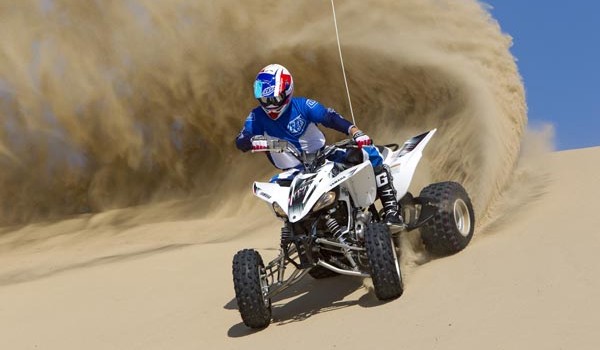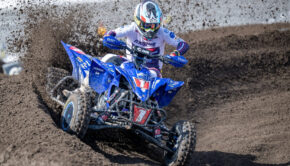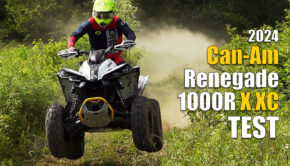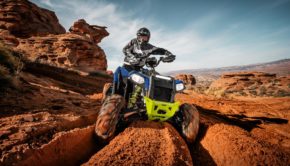2012 Yamaha YFZ450 Test
The Legendary YFZ450 Returns, Offering the Most Performanc
e for the Dollar in Sport ATVing Today!
Over the past 20 years, Yamaha has been the undisputed leader of the Sport ATV class–– at least, in our opinion. They’ve done it by offering a larger number of available models at any given time, and by leading in innovation and new model development.
While financial times have gotten harder for many prospective ATV enthusiasts, the price of purchasing a sport ATV seems farther and farther out of reach, unless you are willing to settle for a smaller displacement machine with more limited performance. Even big blue has fallen prey to the falling dollar forcing them to turn their innovative skills in a more financial friendly direction.
Creating a new budget model would cost millions of dollars in development and production costs, which, of course, would have to be built into the model’s retail price. To keep costs down, Yamaha turned to existing technology, resurrecting the legendary YFZ450. With the R&D long since paid for, plus the addition of a few cost-cutting updates and enhancements, Yamaha is delivering the 2012 YFZ450 for $300 less than it cost when it was released back in 2004, and $700 less than when it was shelved back in 2009!
Updates
The 2012 YFZ450 isn’t an updated 2004 model; it enjoys nearly all of the improvements that were available on the 2009 model. For the re-release, Yamaha wanted to improve the YFZ engine’s ride-ability, without taking away from its historically exhilarating power delivery. To start, they tweaked the cam profile to increase bottom-end and midrange power. Next, the YFZ’s 39mm FCR was swapped out for a 42mm BSR carburetor. They credit the new carburetor with improved throttle response, reduced throttle effort, and for helping maintain the engine’s top-end power; however, we are unsure as to what effect this will have on the engine’s power output in a highly modified state of tune. It’s likely that the carburetor switch was also a price-reducing tactic, with the FCR retailing for around $600. Yamaha claims the YFZ enjoys a 12% increase in power from 4000 to 8000 RPMs, with an 18% increase from 4000 to 6000 RPMs. Peak horsepower remains virtually identical to the 2009 model and the increased low-end and midrange power comes at the small expense of 4% power between 9000 and 10000 RPMs.
Suspension was a component where Yamaha worked to cut costs without compromising performance for the average rider. The 2012 YFZ’s shocks provide the same 9.1-inches of travel up front and 10.6-inches of travel at the rear wheels, identical to the previous model YFZs. What’s missing are the front shock reservoirs and the compression and rebound adjustments at both ends, although preload adjustment remains. While this sounds like a big deal, honestly, most riders don’t take advantage of the tuneability found in today’s high-end suspension components. If you feel you would benefit from the extra adjustability of the YFZ’s old shocks, you can find them reasonably priced on Ebay. If you are planning on modifying your YFZ for racing, the difference in its retail price will go a long way in purchasing a set of aftermarket suspension.

A full line of GYTR components allow you to customize your YFZ450 and enhance its performance, with true OEM quality and fitment. Check out the new FMF/GYTR exhaust.
The YFZ450 is still one of the lightest ATVs in the 450 class, although Yamaha is claiming a minor increase in weight of 9 pounds, from 372 pounds in 2009, to 381 pounds in 2012. We found this a bit surprising, as we expected the suspension components to actually be a bit lighter.
Other updates to the YFZ include new, lighter weight, aluminum wheels with a rolled inner lip, which provides greater strength and prevents dirt from entering. New front Dunlop tires reduce unsprung weight and were designed to reduce steering effort. The latest version is available in black or white, with your choice of four One Industries 2012 Yamaha Graphics, plus the seven other styles One Industries offers. Purchasers of a new Yamaha can customize their One Industries graphics on the One Industries website using their One ID feature.
The Test

Yamaha wanted to stress that the YFZ offers 450cc class performance at a 400cc price. To prove it, they invited us to Winchester Bay, to ride in the Oregon Dunes.
Yamaha wanted to stress that the YFZ offers 450cc class performance at a 400cc price. To prove it, they invited us to Winchester Bay, to ride in the Oregon Dunes. The Dunes span 40 miles of Oregon’s central coastline, providing 5,900 acres of sand. More than a giant sandbox like Glamis or Dumont, Oregon’s dunes offer miles of marked, wooded trails allowing us to test both the YFZ’s power and handling prowess, while enjoying some of the most beautiful land and seascapes on Earth.
When Yamaha first developed the YFZ, it did so with racing in mind. Its ergonomics are compact, yet comfortable, best suiting small to medium-sized riders and aggressive racer types who like a tighter relationship between the bars, seat, and pegs. While its wide pegs and quality controls work well, larger, less aggressive, or all day riders may prefer a more stretched out cockpit like the ones found on Yamaha’s YFZ450R or Raptor 700. A simple set of handlebars, or handlebar risers, could easily provide more room if desired.
When it was discontinued, the YFZ’s five valve, double overhead cam, 449cc four-stroke engine was still one of the fastest, hardest hitting power plants in the 450cc class, and for 2012 that hasn’t changed. The increase in low-end power was clearly evident when getting rolling, or if you let the revs drop on the face of a dune. If you fall off the pipe, the YFZ still sounds a little jittery, reminding you that it prefers to be ridden in the upper two-thirds of the RPM range; however, it is now more willing to pull itself up into the midrange, with less need to backshift or slip the clutch.

we’re glad to see that Yamaha didn’t take the thrill out of the YFZ450’s engine, which can still hold its own on the hill, track, and maybe more so in the woods.
The engine’s midrange greets you with a solid surge of power, and then continues to rev to the moon. Two-stroke lovers and disgruntled would-be Banshee owners could find satisfaction with the YFZ’s engine. In a sea of super smooth, seemingly electric-powered fuel injected four-strokes, the YFZ continues to deliver its power in a bit more abrupt manner, letting you know you have entered the business part of the power band. While it may be a bit more user friendly, we’re glad to see that Yamaha didn’t take the thrill out of the YFZ450’s engine, which can still hold its own on the hill, track, and maybe more so in the woods.
Working your way through the gearbox blazing across the dunes, the YFZ offers smooth shifting and light clutch action. The gear rations are well-spaced and the clutch holds up to abuse under a stock, or lightly modified, engine.

Yamaha has once again proved that you don’t need lots of expensive adjustments to build a decent performing shock.
Yamaha has once again proved that you don’t need lots of expensive adjustments to build a decent performing shock. The Performance of the YFZ’s suspension seemed well-rounded. Jump landings were easily soaked up. Through the whoops, the suspension kept the wheels tracking predictably, with rear shock working best with our weight back and the throttle on. The shocks felt compliant through small chop; however, with the sand offering a much softer surface than the rocks and roots we normally encounter back East, we reserve our final judgment on the shocks’ small bump performance, but so far, we are impressed with what you get for the money.
A mild, steel frame with aluminum upper a-arms, cast aluminum swingarm, aluminum subframe, plus numerous other weight saving items result in a nimble handling machine. The YFZ goes where it is pointed on tight switchbacks and on broad, sweeping turns. Cornering stability is excellent for a 46.1-inch wide sport quad, thanks to its low 31. 9-inch seat height, low center of gravity, plus tire and suspension setups that don’t initiate body roll.
Good carving manners didn’t come at the expense of high-speed stability, allowing you to skim straight through whoops at high speed when you’re on the gas. Although the YFZ is in no way wheelie prone, the responsive engine and well-balanced chassis make lofting the front end easy. The 450 launches straight out of the hole and carries its balanced characteristics into the air, flying level off of jumps. All in all, the YFZ delivers a fun, predictable platform with which to take advantage of the engine’s generous power.
High performance brakes slow you quickly on the YFZ. They offer superb power and feeling thanks to dual piston calipers at both ends. Dunlop’s 21×7-10 front and 20×10-9 rear tires transferred a decent amount of accelerating, braking, and directional control to the sand for general use sport knobbys. We know for a fact that these rear tires also work well on the track and trail and suspect the same from the new fronts.
2012 Yamaha YFZ450
Summary: If you are considering going sport ATV shopping, you should be aware, the 2012 Yamaha YFZ450 provides the most performance for the dollar of any sport ATV available today!













